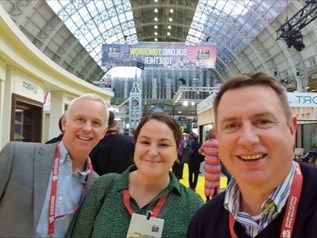London Build 2023: Digitally Transforming the Built Environment
London Build took place on 15th and 16th November.  This is the UK's biggest Festival of Construction, featuring 30,000+ attendees, 500+ speakers across 8 CPD stages and 350+ exhibitors. I was delighted to attend the Expo, alongside my colleagues Phill Welch and Joanna Lorente-Chapman.
This is the UK's biggest Festival of Construction, featuring 30,000+ attendees, 500+ speakers across 8 CPD stages and 350+ exhibitors. I was delighted to attend the Expo, alongside my colleagues Phill Welch and Joanna Lorente-Chapman.
The Expo stages were packed!! I spent most of my time at the major and mega projects stage and the digital construction stage. Thanks to the panellists for debating the key challenges and opportunities for the construction sector.
Data, people, and process enabled by technology were the common threads throughout the sessions. We need to start with outcomes, use cases and purpose to digitally transform the construction sector. Digital twins for example is an approach not a technology for smarter asset and infrastructure operations and maintenance.

Information Management
A message that was repeated by panellists throughout the 2-day Expo is that organisations see value in digital for delivering increased productivity, reducing, or avoiding costs, and increasing their output. Information management across the built environment asset and infrastructure lifecycle is fundamental to enabling digitalisation. Organisations should have a digital mechanism for defining their information requirements and then procuring, receiving, assuring, and storing (via a system of record), and sharing the information that they procure.
Another message that was repeated by the panellists is that information management is not effective unless the information is of an agreed quality and standard before being structured and integrated into a larger system or shared for wider consumption and decision-making.
“The digital journey for the built environment requires quality data, that is joined up and flows to where it is needed”.
Matthew White, Head of Built Environment, 1Spatial
Multiple stakeholders (asset owners, contractors, and suppliers) capture, hold and share information about built environment assets throughout the lifecycle of assets. Where information is being used to manage strategic built environment assets – such as buildings, road networks, airports, flood defences or power stations – challenges may arise when information needs to be integrated from multiple data owners.
To create strong data foundations and “the golden thread” that allow organisations to  share information and have confidence in their information, information quality is critical. Rather than construction Information Managers or Document Controllers for example, resorting to repetitive manual information assurance processes, it is important that organisations establish information management and an information assurance regime to identify and rectify errors according to a set of predefined requirements and rules.
share information and have confidence in their information, information quality is critical. Rather than construction Information Managers or Document Controllers for example, resorting to repetitive manual information assurance processes, it is important that organisations establish information management and an information assurance regime to identify and rectify errors according to a set of predefined requirements and rules.
The process of information assurance impacts the quality of the information available to organisations and in turn enables them to draw more insight and value from their information. This creates direct benefits for the organisations using information, as well as benefits for the wider economy, society, and the environment. Automated information assurance improves the quality, availability, and timeliness of the information available to organisations – facilitating more efficient and effective decisions and investments. Quality is about meeting agreed requirements and ensuring:
- Accuracy - data is correct in all details and is a true record of the entity it represents.
- Completeness – data has all or the necessary attribute values relative to its intended purpose.
- Uniqueness – a single representation exists for each entity or activity.
- Validity – data conforms to all standards expected.
- Timeliness – data is easily accessed or available when required and is up to date.
- Consistency – an entity that is represented in more than one data store can be easily matched.
“Asset and infrastructure integrity needs data integrity.”
Matthew White, Head of Built Environment, 1Spatial
Collaborate on the Rules for Information Quality
During the Expo there were many references to collaboration and agreeing approaches with all teams and stakeholders. Collaborating on the rules is a great way to help organisations maintain information quality and reliability across the supply chain (asset owners, contractors, and suppliers). They are a great way to explicitly assure information against specified requirements. They also become an independent way to catalogue (a rule book), version and report what assurances are performed on information so that organisations can collaborate with all users. This allows organisations to be clear with everyone about the context organisations have used to determine that information is fit for purpose and trusted.
1Spatial’s approach enables organisations to collaborate on the rules for information quality - authoring, cataloguing, and sharing rules as machine readable rules and then automating information assurance and reporting against specified rules, rather than the traditional approach of just checking manually for information which is in violation of requirements.
Collaborative Information Quality = Requirements + Rules + Reporting
1Spatial is working with organisations across the built environment to build and maintain trusted data repositories (data foundations) of the built environment, by automating information management assurance throughout the built environment lifecycle. Structured data repositories of the built environment have the capacity to meet operational needs and provide foundations for digital transformation, for example, digital twins.
Author: Matthew White, Head of Built Environment, 1Spatial
What next?
If you would like to find out more, look at 1Spatial’s Built Environment web page and please contact us.
Learn more
